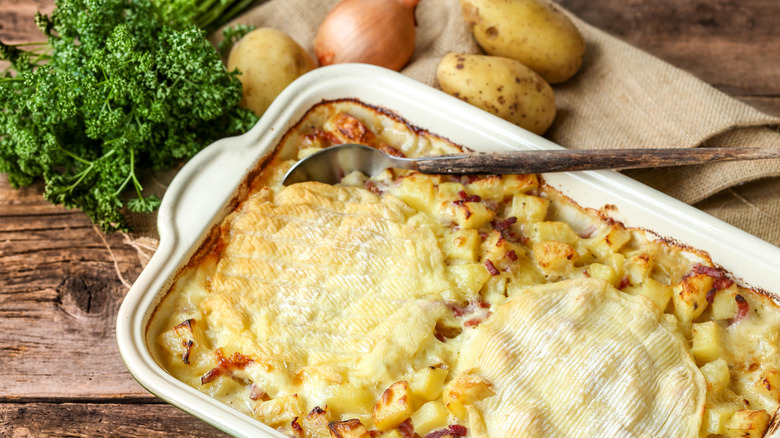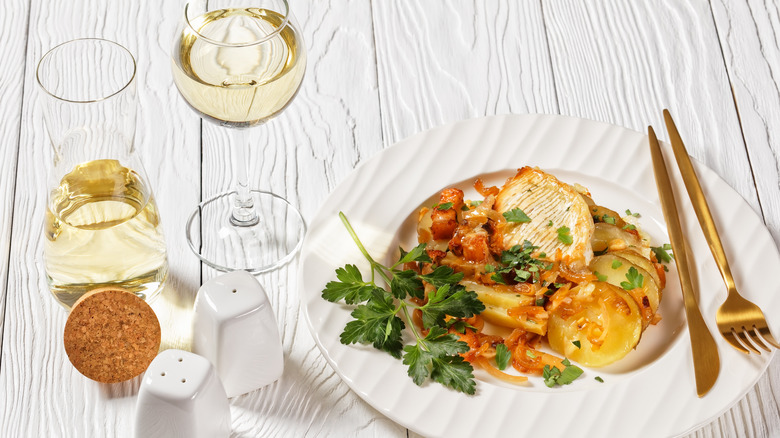Tartiflette: The Cheesy Potato Dish That Won Anthony Bourdain's Praise
It's hard to think of a more universally loved combo than cheese and potatoes. From the not-quite-pasta Italian gnocchi covered in creamy gorgonzola sauce to llapingachos (Ecuadorian cheese-stuffed potato pancakes), the two are paired together in cuisines all around the world. But when it comes to a cheesy potato dish that could rival any other in richness, it's hard to top the French tartiflette, which earned Anthony Bourdain's approval — a feat in itself. Evident in his criticism of trendy Kobe beef sliders, the late chef and author wasn't a fan of rich dishes catered to rich diners. But tartiflette is luxurious for the sake of comfort, not for bragging rights.
While technically a casserole, tartiflette isn't like other casseroles. (However, it's perhaps most similar to potatoes au gratin, another French dish.) It features layers of cooked potatoes, pan-fried bacon and onions, and irresistibly creamy Reblochon cheese baked until the top is bubbling and golden-brown. Bourdain shared a recipe for tartiflette in his Les Halles cookbook, a tribute to his time spent cooking in the French-brasserie-style restaurant in Manhattan. Of the comforting casserole, he wrote, "Here's more evidence that you can never have too much cheese, bacon, or starch."
Despite his globetrotting, Bourdain held a significant soft spot for French cuisine, perhaps in part because of his roots. He wrote in Bon Appetit that he learned from his French father that "the value of a dish is the pleasure it brings you." It's safe to say that tartiflette is a particularly pleasurable dish.
What exactly makes tartiflette so special?
The secret of tartiflette lies in the cheese. The star of the dish is the semi-soft, mild Reblochon, a slightly yellow-rinded disc that's impressively creamy and has a pleasantly nutty aftertaste. Made in the mountains of the Haute-Savoie region of France, the cheese dates back to the 13th century, when farmers would pay their rent with dairy — all while slyly reducing its price. When landlords came to collect, farmers would partly milk their cows in the morning, forking over "all" of the liquid gold as payment and lowering production expectations. Farmers would then return in the evening to milk the cows again, reserving the even richer dairy for themselves. This act of re-milking roughly translates to "reblocher," giving Reblochon — the cheese made from this rich, late-day milk — its name.
Unfortunately, Reblochon is illegal in the U.S., as it's unpasteurized and isn't aged long enough to satisfy U.S. food safety standards. So unless you have an illicit dairy dealer willing to slide you a tomme of this raw-milk cheese under the table, you'll have to make tartiflette with a substitute. It's best to prepare the dish with a similarly soft, washed-rind melting cheese. Taleggio, Camembert, Delice de Jura, or Brie are all worthwhile swaps. The alternatives may not be quite as gooey as real Reblochon, but alas, there are bound to be some challenges when cooking French cuisine in a distant land. Besides, it's hard to go wrong with potatoes covered in cheese, no matter the kind.
How to serve tartiflette
A savory dish that certainly isn't known for being light, the cheesy tartiflette is exceptionally rich and creamy. When preparing this French casserole, consider pairing it with something that balances out its indulgent flavors. The dish is best served alongside a crisp green salad with a tart, acidic vinaigrette. If you're preparing a cozy tartiflette during the cold months, a fitting decision as Reblochon is traditionally associated with winter, you may want to opt for a slightly heartier and similarly warm side. For instance, roast seasonal vegetables with Herbs de Provence, then drizzle them with fresh lemon juice before serving. Like the vinaigrette, the citrus will cut through the creaminess of the casserole, refreshing your tastebuds while focusing their attention on the subtler flavors in the dish.
When it comes to choosing something to sip on, go with a glass of French white wine, leaning into the regional origins of tartiflette. A sweet, crisp, and acidic wine will round out the rich, gourmet meal very nicely. However, if you are serving salad, be mindful to choose a wine that doesn't clash with the dressing. If its acidity pales in comparison to the vinaigrette, the wine may end up tasting flat.
Manage to save room for dessert? Finish off dinner with something sweet. From a dreamy coffee-soaked, chocolatey opera cake to a petite rum-flavored canelé, there are plenty of decadent French cakes worth ending the night with. Bon appétit!


